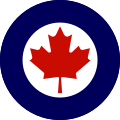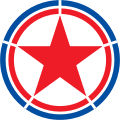Roundel: Difference between revisions
| Line 63: | Line 63: | ||
Image:RCAF-Roundel.svg|<center>[[Royal Canadian Air Force]]</center> |
Image:RCAF-Roundel.svg|<center>[[Royal Canadian Air Force]]</center> |
||
Image:Roundel of the Netherlands border.svg|<center>[[Royal Netherlands Air Force]]</center> |
Image:Roundel of the Netherlands border.svg|<center>[[Royal Netherlands Air Force]]</center> |
||
Image:Roundel of the Pakistani Air Force.svg|<center>[[Pakistani Air Force]]</center> |
Image:Roundel of the Pakistani Air Force.svg|<center>[[Pakistani Air Force|Pakistan Air Force]]</center> |
||
Image:Swiss roundel.svg|<center>[[Swiss Air Force]]</center> |
Image:Swiss roundel.svg|<center>[[Swiss Air Force]]</center> |
||
Image:Roundel of the Royal Thai Air Force.svg|<center>[[Royal Thai Air Force]]</center> |
Image:Roundel of the Royal Thai Air Force.svg|<center>[[Royal Thai Air Force]]</center> |
||
Revision as of 12:33, 21 March 2013

A roundel in heraldry is a disc; the term is also commonly used to refer to a type of national insignia used on military aircraft, generally circular in shape and usually comprising concentric rings of different colours.
Heraldry
In heraldry, a roundel is a circular charge. Roundels are among the oldest charges used in coats of arms, dating from at least the twelfth century. Roundels in British heraldry have different names depending on their tincture.[1] Thus, while a roundel may be blazoned by its tincture, e.g., a roundel vert (literally "a roundel green"), it is more often described by a single word, in this case pomme (literally "apple", from the French) or, from the same origins, pomeis—as in "Vert; on a cross Or five pomeis" (Scottish Public Register vol. 32, p. 26).
| metals | colours | neutral | |||||
|---|---|---|---|---|---|---|---|
bezant coin |
plate silver |
hurt berry |
torteau cake |
pellet gunshot |
pomme apple |
golpe wound |
fountain fountain |

In French blazon, a roundel of either metal (or or argent) is a besant, and a roundel of any colour (dark tincture) is a torteau, with the tincture specified.
One special example of a named roundel is the fountain, depicted as a roundel barry wavy argent and azure, that is, containing alternating horizontal wavy bands of blue and silver (or white). Because the fountain consists equally of parts in a light and a dark tincture, its use is not limited by the rule of tincture as are the other roundels. Another name for the fountain is the syke (Northern English for "well").[2]
Another special roundel, largely confined to Scots heraldry, is the gurges filled with a double spiral of contrasting tinctures. A gurges argent and azure can be seen in the arms of James Watt College.
In their earliest uses, roundels were often strewn (semy) upon the field of a coat of arms, a design with as many names as there are tinctures. For example, a field semy of roundels argent could be called platy; a field semy of roundels sable could be called pellety. The precise number and placement of the roundels in such cases were usually left to the discretion of the artist.
Because of their long use and simple outline, roundels are accorded status as a subordinary charge by most heraldic writers.
The term roundel also describes a circular shield used for heraldic display (as opposed to other forms such as the more common escutcheon or lozenge). An example of arms borne on a roundel is the Coat of Arms of Nunavut.
Military aircraft

The French Air Service originated the use of roundels on military aircraft during the First World War.[3] The chosen design was the French national cockade, whose colours are the blue-white-red of the Flag of France. Similar national cockades, with different ordering of colours, were designed and adopted as aircraft roundels by their allies, including the British Royal Flying Corps and the United States Army Air Service. After the First World War, many other air forces adopted roundel insignia, distinguished by different colours or numbers of concentric rings.
Military aircraft insignia, such as that of the Philippine Air Force and the Polish szachownica, are often called roundels even when they are not round.[citation needed]
Corporate use
Some corporations and other organizations also make use of roundels in their branding; employing them as a trademark, or logo.
In popular culture

- The roundel, especially that used by the Royal Air Force, has been associated with pop art of the 1960s, appearing in paintings by Jasper Johns. It became part of the pop consciousness when British rock group The Who wore RAF roundels (and Union Flags) as part of their stage apparel at the start of their career. Subsequently it came to symbolise Mods and the Mod revival.
- Some of Paul Weller's material involves the use of a roundel in psychedelic colours.
- Ben Harper's album Fight For Your Mind uses roundels from several air forces as graphics in the liner notes.
- In the British television series Doctor Who, the circular decorations on the interior walls of the TARDIS control room are known as roundels.[4]
Examples
Military aircraft roundels
Corporate logo roundels
Corporate logos incorporating roundels include London Underground, Target, BMW, Volkswagen, and the Winnipeg Jets NHL team.
See also
Notes
- ^ Fox-Davies, Arthur Charles (1909). A Complete Guide to Heraldry. p. 151.
- ^ Fearn, Jacqueline (1980). Discovering Heraldry. Shire. p. 25.
- ^ Royal Air Force Museum
- ^ Russell, Gary (2006). Doctor Who: The Inside Story. London: BBC Books. p. 86. ISBN 0-563-48649-X.
References
- Smith, Whitney (1975). Flags: Through the Ages and Around the World. McGraw Hill. pp. 24, 342. ISBN 0-07-059093-1.
- Donald, David, ed. (1986). The pocket guide to Military Aircraft and the World's Air Forces. Temple Press Aerospace. pp. 136–189. ISBN 0-600-55002-8.













